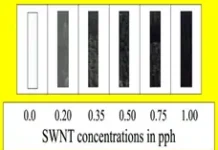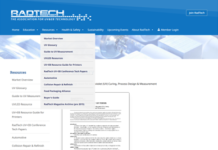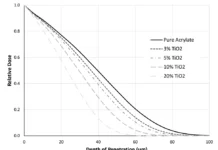I was drafted (volunteered) to take this column over from Dick Stowe when he finally convinced the editors of UV+EB Technology that he wanted to slow down a little. We owe Dick a big thanks for the work he has done to educate and help users understand UV technology, measurement and process control. He has done this not only with this column but over a long career, and I have some pretty big shoes to fill.
The editors have left this first column up to me. Voltaire’s saying “with great power comes great responsibility” first comes to mind. (Voltaire is credited with this saying before Uncle Ben in Spiderman.) A more appropriate Voltaire quote when it comes to UV technology is “Common sense is not so common.”
I hope to use “common sense” to address UV technology questions from both a technical and practical point of view: Understand the technical aspects of UV measurement, and apply them in a practical manner.
A.
UV LEDs are solid-state devices that are expected to have a stable output over thousands or even tens of thousands of hours. If they are so stable, a frequent question is: Why should I measure UV LEDs?
The reasons to measure UV LEDs are similar to the reasons to measure broadband sources. Measuring a UV LED allows you to do the following:
- Save time and money through reduced scrap and increased yield
- Establish a process window
- Communicate with your supply chain
- Transfer the process from the lab to production
- Drive maintenance programs
- Troubleshoot, if the process is not working
- If required, provide a certificate of conformance to your customers
What should I measure?
With a UV LED, this column assumes that you have matched the LED output wavelength to the chemistry in your application. That leaves two parameters to measure: LED irradiance and energy density.
Irradiance
In everyday terms, irradiance is the power, or “brightness,” of your UV source. Irradiance is measured in Watts/cm2. Manufacturers typically specify UV LED output in Watts/cm2 measured at array’s optical window or “at the glass.” With UV LEDs, the irradiance is a parameter that can change over time based on power settings, distance and cleanliness of the optics window. With broadband lamps, irradiance can be impacted by lamp aging and reflector cleanliness. A radiometer can help you determine how the UV LED performs at different heights above the substrate.
Energy Density
Sometimes referred to as “dose,” energy density is the second factor critical to proper curing. Energy density is the exposure of UV-curable material to a certain irradiance for a certain amount of time. The measure of energy density is in Joules/cm2. A one-Watt exposure for one second equals one Joule.
To cure coatings, inks and adhesives, both irradiance and time must be within the established process window. Like a recipe that requires a certain oven temperature and cooking time for best results, UV curing recipes usually require minimum irradiance and exposure time (energy density).
What process variables should be monitored?
If you could be sure that everything associated with your process would remain the same over time, the process could be locked down and forgotten – a “set it and forget it” approach. In the real world, things change. We divide the things that can change into two broad categories: “natural” causes (i.e. equipment failure) and “unnatural” causes (i.e. operator changes). Some possibilities are shown in Tables 1 and 2.
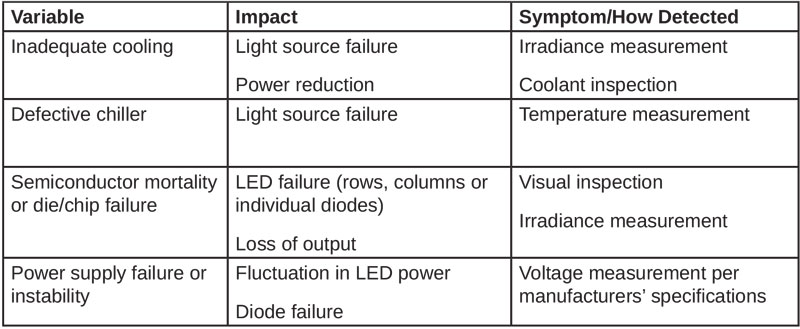
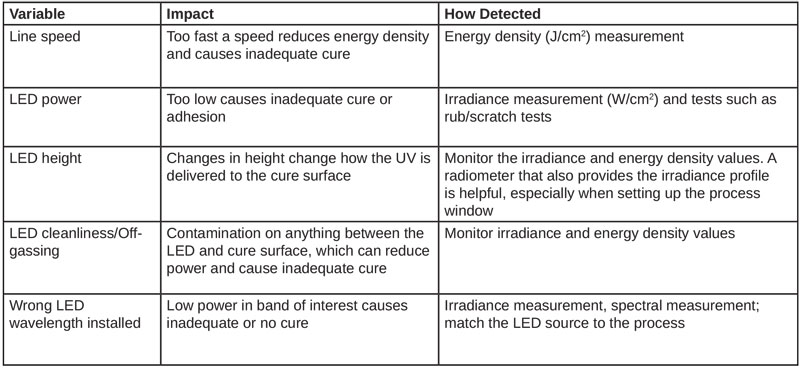
Even when armed with good theoretical knowledge, mistakes can be made due to simple, practical misunderstandings. The bottom line is to make sure you know what type of source is being used and then to use an instrument matched to both the source and intensity.
In the next column, we will look at real world examples when a simple misunderstanding or lack of needed knowledge caused additional work. If you have questions that you would like answered, email Dianna Brodine, managing editor of UV+EB Technology, at dianna@petersonpublications.com.
A parting thought:
A photon checks into a hotel. The bellhop asks, “Can I help you with your luggage?”
The photon replies, “I don’t have any. I’m traveling light!”
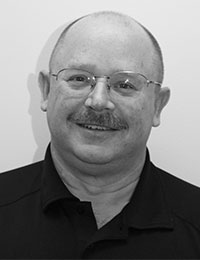 Jim Raymont
Jim Raymont
Director of Sales
EIT LLC
jraymont@eit.com


